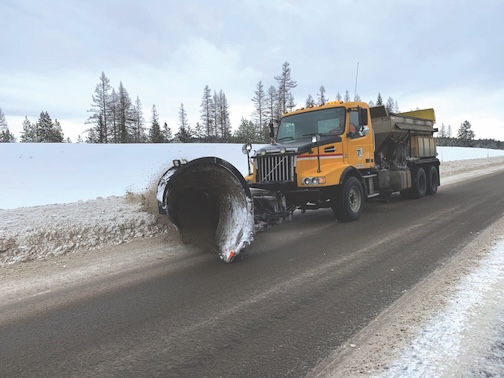Wolf suspected in lamb deaths
Published 3:54 pm Tuesday, April 14, 2009
BAKER CITY – A wolf is suspected of killing 19 lambs on a Keating Valley ranch in what would be the first confirmed case of wolves attacking livestock in Oregon since the animals returned to the state several years ago.
Trending
Following several reported wolf sightings in Keating Valley, rancher Curt Jacobs reported finding what appears to be wolf tracks in the muddy pen where the 19 lambs were mauled.
A camera set up by the Oregon Department of Fish and Wildlife at the Jacobs’ ranch, about 15 miles northeast of Baker City, photographed what appears to be a wolf Monday night, according to Wyn Lohner, Baker City Police chief, who lives in Keating Valley.
“Most of the lambs were killed but not eaten,” said Jacobs, who made a plaster cast of one paw print measuring about 4 inches wide by 5 inches long.
Trending
On Monday morning, Jacobs reported that 19 of 22 lambs that were attacked had been killed, and two ewes suffered broken shoulders.
According to ODFW, Jacobs’ sheep were attacked twice – one on Thursday night that left 16 lambs dead and a second on Sunday night, which Jacobs said left three more dead lambs.
Several other lambs and ewes are missing, and Jacobs said they may have been dragged off. Based on the size of the paw impressions in the mud, and the manner in which the sheep were attacked, the attacks are suspected to be the work of at least one wolf and possibly two.
“No other ranches have reported sheep killed by wolves in Oregon,” Jacobs said. “I’d be the first one, if the ODFW confirms it was a wolf.”
Russ Morgan, ODFW’s wolf coordinator, said Monday that he ruled out coyotes due to the large size of the paw tracks and other factors.
“The tracks are bigger than coyote tracks. I am sure they are not coyote tracks,” Morgan said.
Morgan said cougars had also been ruled out due to the shape of the prints, which is canine rather than feline, and the nature of the wounds to the lambs.
“In recent months we have found some wolf tracks five or six miles from here, near the forest line,” Morgan said. Some of those wolf tracks were confirmed by ODFW with the past month.
However, he said the wolf tracks confirmed in the forested area were even larger and appeared to be from different wolves than the ones that killed the Jacobs’ sheep.
On Monday, before the photo was taken, Morgan said he was hoping to trap or photograph the predator attacking the sheep to positively confirm that the attacks were the work of a wolf or wolves.
“I haven’t ruled it out. There is that possibility,” Morgan said. “I am here to help solve the mystery of what killed their sheep.
“Our role is to look at all the evidence and sort this out,” Morgan said.
Morgan said earlier this year ODFW confirmed reports of a lone wolf near the timberline, but previously he said there’s been no previous confirmed sightings of a wolf or wolves in the agricultural lands in the Keating area, where cattle, sheep and hay are the primary crops.
Jacobs said the situation could have been much worse if he hadn’t moved the single ewes and lambs to a higher southwest of his main ranch.
At the time of the first attack Thursday night, only the twin ewes and twin lambs were left in the fenced pastures around the main ranch, near Jacobs’ houses and barns.
After three more dead lambs turned up Monday morning, indicating the predator had returned Sunday night, Morgan recommended Jacobs leave the carcasses of those sheep in the pasture to lure the predator so it could be trapped or photographed by cameras.
“They don’t want us using the “Big W” word. If we catch one or get a picture of it, then we can say it’s the “Big W,” Jacobs said on Monday morning.
Although the federal government plans to remove gray wolves, including those in Eastern Oregon, from the endangered species list, that change doesn’t take effect until May 4.
“From a private landowner standpoint, there is no ability to harm the animal at all, if it turns out to be a wolf,” said Gary Miller of the U.S. Fish and Wildlife Service.
A person convicted of killing an endangered animal could be fined up to $100,000 and sentenced to a year in jail.
Even if wolves are removed from the endangered list – the federal government tried to do so in 2008 but a judge overturned that decision after groups sued – wolves will remain protected under Oregon’s endangered species law.
What that means for ranchers such as Jacobs is that they can’t do anything more than haze a wolf or wolves attacking their sheep, Morgan said.
“Even if we catch a wolf with a sheep in its mouth, we can’t get a gun and shoot it,” Jacobs said.
Under the state endangered species act, wolves are to remain listed as endangered until two breeding pairs have been confirmed in three consecutive years, according to information posted on the ODFW Web site.
Elton and Loretta Cook, who live near the forest line about five miles from the Jacobs’ ranch, said they reported seeing wolves and finding wolf tracks starting two years ago and as recently as March 27,
“About two years ago I saw two crossing the road right below my house, nine miles northwest of Keating on Cook Road,” said Elton Cook.
“The wolves crossed the road right in front of me. They were silver wolves,” Cook said. “I have seen lots of wolves in Alaska, so I know what they look like.
“We’ve also seen a black wolf several times right in this same vicinity. He is a lone black wolf, and he is much bigger than the silver wolves,” Cook said.
Loretta Cook said the couple’s daughter, Cindy Lenhart, and her husband were out riding near the forest line on March 27 and found wolf tracks.
“They saw two wolf tracks going up the road and took pictures of them,” she said. “They put a pen down and her husband put his hand next to the tracks to show how large they were,” Loretta Cook said, adding that they were around 6 inches long.”









